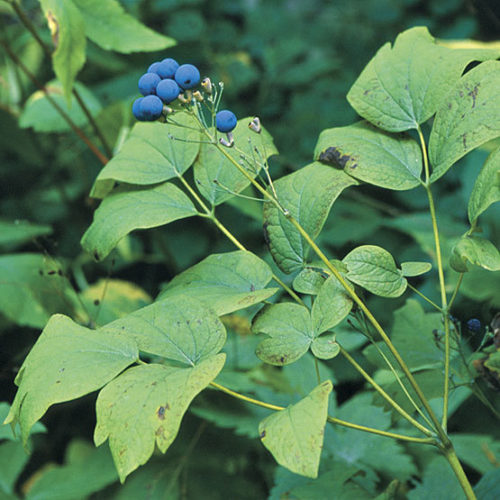Ancient Roots of Blue Cohosh
For centuries, North American woodlands have been home to Blue Cohosh, which has flourished deep within them. The value of this plant became apparent to Indigenous communities, who incorporated it into their medicinal and spiritual rituals. People admired this woodland perennial for its remarkable beauty, and they also valued it as a traditional healing plant whose properties had been handed down through generations. Native American medicinal practices influenced early European settlers, who adopted their use and incorporated it into their herbal remedies. Traditional medicine applications for this plant date back to the 18th century, according to historical records, which helped establish its dual role in healing practices and folklore.
A Healer’s Secret Blue Cohosh
Blue Cohosh has served as a fundamental component of natural medicine for hundreds of years. Indigenous healers primarily used this plant to treat women’s health conditions, including childbirth complications and menstrual issues. Midwives considered this plant a valuable aid because they brewed it into teas or tinctures, which helped with labor. The plant served as a treatment for digestive problems, arthritis symptoms, and respiratory conditions in addition to its reproductive health applications. The roots of this plant hold several alkaloids and glycosides, which are thought to deliver anti-inflammatory effects and relieve pain. Modern herbalism continues to utilize extracts from this plant in natural remedies that aim to restore reproductive and hormonal balance. Because of its strong effects, medical use should be accompanied by professional supervision.
Discovery and Early Documentation
The earliest botanical literature documentation of this plant appeared in the early 1700s during European settlers’ efforts to record North American plant life. The value of this plant had been known to Native American tribes for generations until herbalists and apothecaries later acknowledged its medical properties during their search for plant-based treatments in Western medicine. By the 1800s, pharmacies sold this plant, harvested for use as a natural treatment mainly for women's health conditions. The expanding domain of botanical medicine adopted this plant as a fundamental component because early doctors tested various formulations to enhance its therapeutic effects. Traditional applications of this medicine maintain their respect and continue to be researched, even with modern medical progress.
Blue Cohosh: A Woodland Treasure in Landscaping
Blue Cohosh has expanded its presence from medicinal use to become a popular choice for ornamental gardens and naturalized landscapes. This plant's capacity to grow well in shaded and damp conditions makes it a top choice for woodland gardens because it provides texture along with seasonal appeal. Gardeners treasure the distinctive foliage, which starts with a purplish color and transforms into a deep blue-green over time. The plant reveals delicate yellowish-green flowers during spring, which create a subtle yet sophisticated display. During the later part of the growing season, the garden becomes more visually complex when striking blue berries develop. Shade-loving perennials such as ferns and various other plants are often combined with this species to create layered and lush garden bed designs. The plant's ability to thrive in diverse soil environments, combined with its deer-resistant properties, makes it highly desirable for naturalistic planting designs.

A Striking Presence: Appearance and Growth Cycle
This plant transforms throughout the growing season from early spring until late fall to become a standout feature in shaded forest grounds and landscaped areas. The plant starts with bluish-purple leaves that slowly change to soft green during their growth process. Although small and unassuming, these flowers display distinctive charm through their yellow-green petals and gently drooping appearance. During the growing season development the plant generates striking blue berries that stand out vividly against its dark green leaves. The berries on this plant are not edible but they enhance its decorative appeal, which makes it a standout choice for woodland garden designs. This plant grows to a height of two to three feet, making it ideal as an undergrowth companion in naturalized environments.
Blue Cohosh: A Haven for Rare Wildlife
The plant stands out because it provides essential support to rare wildlife species. Although this plant fails to draw significant pollinator attention, it supplies vital nourishment for specific insects and birds. Native bees pollinate its small flowers, and woodland birds consume its distinctive berries. These berries provide essential food for birds like thrushes and ground-feeding species during late summer and early autumn when other food supplies become scarce, despite being inedible to humans. The dense vegetation of the plant functions as a protective habitat for small forest animals while it enhances biodiversity in shaded woods. Native ecosystems benefit from the presence of species, which creates stability by supporting organisms dependent on shaded and damp environments.
Conclusion
The existence of Blue Cohosh demonstrates the profound link between natural ecosystems and human cultural practices. The plant maintains its status as a beloved woodland perennial because of its extensive historical significance and medicinal strength together with its impressive visual impact on natural landscapes. The plant's capacity to sustain wildlife populations while enhancing the visual appeal of shaded garden spaces makes it even more valuable. The plant merits celebration because people value its healing properties alongside its delicate flowers and role in native habitats.